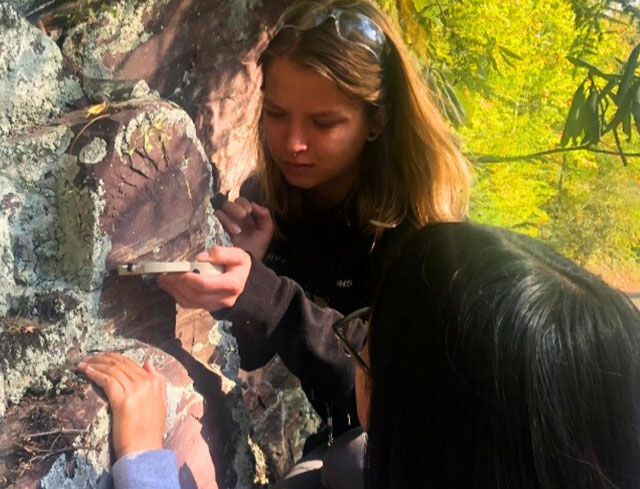The Art of Learning
05 Oct 2022
Celebrating the legacy of Black Mountain College
Story by Kat Ford

In 1933 John A. Rice vacated his position as professor at Rollins College in Winter Park, FL, for something new and polarizing. Several faculty and student supporters followed him, sharing a vision for a superior learning institution inspired by John Dewey's thoughts on progressive education. Dewey believed in learning by doing, and that teachers and students should learn together with a democratic and interdisciplinary approach. Their efforts resulted in a private liberal arts school in rural Black Mountain, NC, 15 minutes outside Asheville. It was owned and operated by the faculty, admitting around 1,200 students total in the 24 years it was open; only an estimated 60 or so graduated. They named their experiment Black Mountain College (BMC). The impact of its legacy on education and the arts continues to this day.
Professors and students lived and ate together. There was no concrete curriculum or grades. Students decided when or if they would graduate. All partook in manual labor, from constructing buildings to farm work and kitchen duty. While often remembered as an art school, the genuine desire was to cultivate thinking citizens, trusting that placing abstract problem-solving, incubated through the arts, as a core discipline would lead to mastering complex thought.
While a learning environment free of constraints would naturally attract the artistic-minded, malevolent circumstances in Europe offered BMC a fortuitous opportunity. The birth of BMC coincided with the rise of Adolf Hitler, the latter leading to the closing of the Bauhaus, an influential art school in Germany, and the fleeing of artists and intellectuals. Many of these creatives found their way to Black Mountain as students and faculty, including Josef Albers, who was hired as BMC's first art teacher. Josef and his wife, textile artist Anni Albers, were pioneers in twentieth-century modernism. Albers would later become chairman of the Department of Design at Yale and the first living artist honored with a solo retrospective at the Metropolitan Museum of Art in New York.
The avant-garde was unquestionably en vogue at Black Mountain. In 1952 John Cage organized what is widely considered the first multi-media Happening in America. "Theatre Piece no. 1" consisted of David Tudor playing the piano, M.C. Richards and Charles Olson reading poetry, Cage speaking, Robert Rauschenberg displaying his paintings on the ceiling while playing records, and Merce Cunningham dancing while being chased by a dog. With the loam of BMC nurturing seeds of experimental thinking, the list of faculty and students who would influence the second half of the twentieth century is distinguished: Arthur Penn, Ben Shahn, Buckminster Fuller, Cy Twombly, Dorothea Rockburne, Francine du Plessix Gray, Franz Kline, Jacob Lawrence, Jonathan Williams, Kenneth Noland, Ray Johnson, Robert Creeley, Ruth Asawa, Susan Weil, Suzi Gablik, Vera B. Williams, Willem and Elaine de Kooning and many more.
For those interested in BMC, articles, books, exhibitions and videos abound. Located in Asheville, Black Mountain College Museum + Arts Center (BMCM+AC) was founded by Mary Holden in 1993. According to Outreach Manager Kimberly English, the museum and arts center was created to "provide a gathering point for people from a variety of backgrounds to interact through art, ideas and discourse." With a permanent collection of over 4,000 objects and oral history documentation that includes recorded interviews with 58 Black Mountain College alumni, this is the most extensive museum collection dedicated solely to BMC in the world.
English invites visitors to BMCM+AC's "current exhibition (through January 7), 'Leo Amino: Work with Material.' Invited by Josef Albers to join the faculty in 1946, a year after the artist began his experiments with polyester and acrylic following their military declassification at the close of WWII, Amino was the only sculptor in the following two decades to use this new industrial medium to produce a full body of work carrying forward the innovations of Constructivism and the Bauhaus with respect to both material and phenomenal transparency." In addition to exhibitions, BMCM+AC also hosts "events and programs that maintain the relevance of this enigmatic experiment in progressive, interdisciplinary education. This involves educational workshops and curriculum-specific field trips, publications, musical performances and artist/author talks," says English.
Those interested in visiting the historic BMC campus can join BMCM+AC for 90-minute tours covering the "lower campus buildings including the Dining Hall, Lodges, the Quiet House and the Studies Building as well as the iconic and recently conserved frescos painted by Jean Charlot and students in the summer of 1944." Wishing you had been there for that iconic first Happening in 1952? Support BMCM+AC during {Re}HAPPENING, a one-day event at the historic campus. Equal parts art event, fundraiser and community instigator, it provides a platform for contemporary artists to share their responses to the legacy of BMC by activating the buildings and grounds of the BMC campus with installations, new media, music and performance projects.
For more information on exhibitions, events, tours and resources visit www.blackmountaincollege.org.













